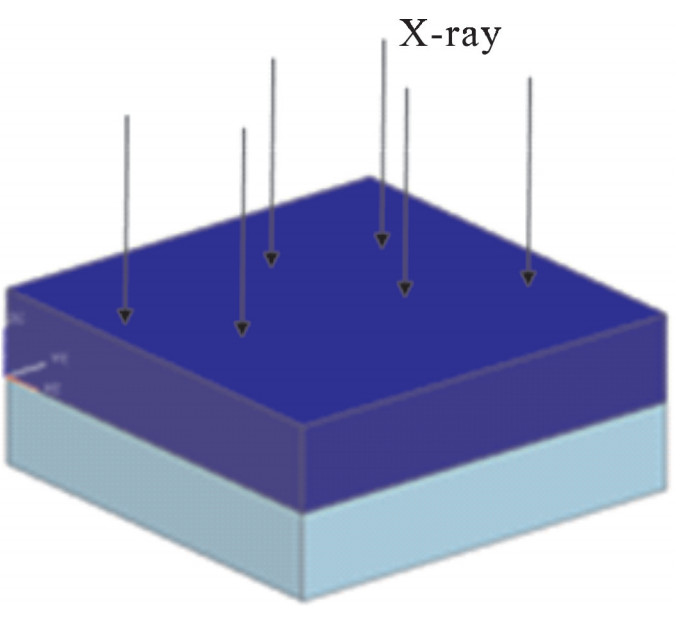Monte Carlo simulations of photon-electron transports of cylinder cavity
-
摘要: 应用三维并行蒙特卡罗程序JMCT, 计算了特征温度分别为1, 3, 5, 8keV的黑体谱X射线入射到铝、二氧化硅、金的表面的背散射光电产额和电子能谱, 并与文献结果进行对比, 验证了程序的正确性, 进而针对系统电磁脉冲(SGEMP)研究中的典型几何结构——金属圆柱腔体, 模拟计算了其在黑体谱X射线照射下的光电输运过程, 用温度为1keV、注量为1J/m2的黑体谱X射线平行照射圆柱腔侧面, 半个侧面发射光电子, 计算得出了和方位角相关的不同面上发射光电子的光电产额、能谱分布和角分布, 结果表明掠入射的X射线会产生更高的光电产额; 光电子的发射角分布都基本符合余弦角分布的规律。Abstract: Using the three dimensional and paralleled JMCT Monte Carlo code, the backscattered photoelectric yields and electron energy spectra are calculated for the cases that black body X-ray sources of temperatures of 1, 3, 5, 8 keV impact on the material surfaces of Al, SiO2 and Au respectively. The simulation results are consistent with the results in references, which verify the validity of the code. Then the typical photon-electron transport example in SGEMP for black body X-rays impacting on a cylinder cavity is calculated. Half of the side-face of the cylinder emits photoelectrons in the case that the black body X-rays of temperature 1 keV and fluence 1 J/m2 impact on the side-face of the cylinder. The photoelectron parameters of photoelectric yield, energy distribution and angular distribution related with azimuth are calculated. The results show that obliquely incident X-ray could induce higher photoelectric yields than normally incident X-ray and the distributions of photoelectrons are all very close to cosine distribution.
-
Key words:
- Mont Carlo /
- JMCT /
- X-ray /
- system generated electromagnetic pulse /
- photoelectron
-
表 1 三种材料背散射光电产额
Table 1. Backscattered photoelectric yields of three materials
temperature/keV photoelectric yields/(electrons·photon-1) photoelectric yields/(electrons·cal-1) Al Au SiO2 Al Au SiO2 1 4.70×10-3 2.13×10-2 3.02×10-3 4.02×1013 1.82×1014 2.58×1013 3 3.10×10-3 1.99×10-2 2.21×10-3 9.77×1012 6.27×1013 6.99×1012 5 2.05×10-3 1.76×10-2 1.55×10-3 3.93×1012 3.38×1013 2.97×1012 8 1.33×10-3 1.48×10-2 1.03×10-3 1.60×1012 1.77×1013 1.24×1012 Note: 1 cal=4.184 J. -
[1] 王泰春, 贺云汉, 王玉芝. 电磁脉冲导论[M]. 北京: 国防工业出版社, 2011.Wang Taichun, He Yunhan, Wang Yuzhi. Introduction to electromagnetic pulse. Beijing: National Defense Industry Press, 2011 [2] 程引会, 周辉, 李保忠, 等. 光电子发射引起的柱腔内系统电磁脉冲的模拟[J]. 强激光与粒子束, 2004, 16(8): 1029-1032. http://www.hplpb.com.cn/article/id/624Cheng Yinhui, Zhou Hui, Li Baozhong, et al. Simulation of system-generated electromagnetic pulse caused by emitted photoelectron in cavity. High Power Laser and particle Beams, 2004, 16(8): 1029-1032 http://www.hplpb.com.cn/article/id/624 [3] Higgins D F, Lee K S H, Marin L. System-generated EMP[J]. IEEE Trans Antennas and Propagation, 1978, 26(1): 14-22. doi: 10.1109/TAP.1978.1141797 [4] Schmidt M J. Elementary external SGEMP model for system engineering design[J]. IEEE Trans Nuclear Science, 1985, S32(6): 4295-4299. [5] Holland R. Comparison of FTDT particle pushing and direct differencing of Boltzmann's equation for SGEMP problems[J]. IEEE Trans Electromagnetic Compatibility, 1995, 37(3): 433-442. doi: 10.1109/15.406532 [6] 孙会芳, 董志伟, 张芳. 系统电磁脉冲一维边界层的数值模拟[J]. 强激光与粒子束, 2018, 30: 013004. doi: 10.11884/HPLPB201830.170210Sun Huifang, Dong Zhiwei, Zhang Fang. Simulation study of the one-dimensional SGEMP boundary layer. High Power Laser and Particle Beams, 2018, 30: 013004 doi: 10.11884/HPLPB201830.170210 [7] 周开明, 王艳, 邓建红. 线缆系统电磁脉冲效应测量系统研制和试验[J]. 强激光与粒子束, 2014, 26: 073207. doi: 10.11884/HPLPB201426.073207Zhou Kaiming, Wang Yan, Deng Jianhong. Development and test of measurement system for cable system generated electromagnetic pulse effects. High Power Laser and Particle Beams, 2014, 26: 073207 doi: 10.11884/HPLPB201426.073207 [8] 周辉, 郭红霞, 李宝忠, 等. 金属壳体和电缆的系统电磁脉冲响应[J]. 强激光与粒子束, 2004, 16(5): 645-648. http://www.hplpb.com.cn/article/id/903Zhou Hui, Guo hongxia, Li Baozhong, et al. Response of metal shell and cables to system generate electromagnetic pulse effects. High Power Laser and Particle Beams, 2004, 16(5): 645-648 http://www.hplpb.com.cn/article/id/903 [9] Carron N J. Characteristic steady-state electron emission properties for parametric blackbody X-ray spectra on several materials[R]. AD-0086, 1976. [10] 郭红霞, 周辉, 常冬梅, 等. 蒙特卡罗方法对黑体辐射谱的光电子参数计算[C]//第9届全国核电子学与核探测技术学术年会论文集. 1998.Guo hongxia, Zhou Hui, Chang Dongmei, et al. Calculation of photoelectric parameter for black-body spectra using Monte-Carlo method//Proceedings of the 9th National Conference on Nuclear Electronics & Nuclear Detection Technology. 1998 [11] 张玲玉, 李瑞, 李刚, 等. JMCT光子-电子耦合输运模拟计算研究[J]. 强激光与粒子束, 2017, 29: 126007. doi: 10.11884/HPLPB201729.170253Zhang Lingyu, Li Rui, Li Gang, et al. Simulation study of JMCT photon-electron coupled transport. High Power Laser and Particle Beams, 2017, 29: 126007 doi: 10.11884/HPLPB201729.170253 [12] 李刚, 张宝印, 邓力, 等. 蒙特卡罗粒子输运程序JMCT研制[J]. 强激光与粒子束, 2013, 25(1): 158-162. doi: 10.3788/HPLPB20132501.0158Li Gang, Zhang Baoyin, Deng Li, et al. Development of Monte Carlo particle transport code JMCT. High Power Laser and Particle Beams, 2013, 25(1): 158-162 doi: 10.3788/HPLPB20132501.0158 [13] Tumolillo T A, Wondra J P, Radasky W A. Plasma effects on the SGEMP space-charge boundary layer[J]. IEEE Trans Nuclear Science, 1980, 27(6): 1608-1615. doi: 10.1109/TNS.1980.4331077 -






 下载:
下载:





